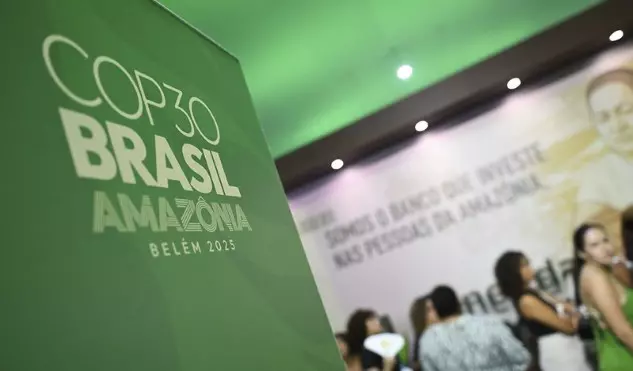According to various estimates, funding for environmental protection faces a deficit of $700 billion per year. In response, new mechanisms of financial solution include biodiversity credits and units.
Threats to Biodiversity
The World Economic Forum estimates that roughly half of global GDP, or about $44 trillion, is heavily dependent on nature. This means that its degradation causes significant damage to the global economy.
Agriculture and aquaculture represent the most significant threat to vital biodiversity zones globally, based on data from the World Database of Key Biodiversity Areas.

Source: The Biggest Threats to Biodiversity on Earth
The categories for the primary threats depicted in the chart correspond to classification by the International Union for Conservation of Nature (IUCN), which are regarded as the highest-level risks to biodiversity and ecosystems. As the graph illustrates, human activity caused many of the primary dangers to biodiversity. For instance, the category of Human Intrusions and Disturbance includes various actions, from recreational pursuits to war, civil unrest, and labor-related activities.
Biological resource utilization involves, among other things, hunting, logging, and timber extraction. Meanwhile, Natural System Modifications involve activities like dam construction. Pollution covers threats such as sewage, oil spills, acid rain, and noise contamination. The categories of Energy Production and Mining, Transportation and Service Corridors are ranked eighth and tenth, respectively. They have been categorized as Other in the chart.
Global Biodiversity Framework
In 2022, 196 nations reached a consensus on a new Global Biodiversity Framework aimed at halting and reversing the global loss of nature. The framework establishes a set of targets to be achieved by 2030 to provide a realistic chance of success. A key aspect of this framework is a significant increase in financial support for conservation efforts, acknowledging that current commitments for nature preservation fall far short of what is needed.
Addressing this financial shortfall is one of the most pressing challenges in conservation. It require drawing from a variety of funding sources. Among the options outlined in the Framework are biodiversity credits and units.
Biodiversity credits
Similar to carbon credits, biodiversity credits were developed as a new tool to preserve biodiversity. These credits are measurable, verifiable, and transferable financial instruments that reward positive environmental and biodiversity outcomes—such as the preservation of species, ecosystems, and natural habitats—through the creation and sale of land- or marine-based biodiversity units over a set period. Simply put, biodiversity credits allow businesses and other significant contributors to invest in nature protection, management, or restoration, while receiving official recognition for their positive environmental impact.
To illustrate: Company A wants to contribute to environmental preservation. To do so, it undertakes activities B aimed at improving or protecting biodiversity, such as restoring habitats or safeguarding specific species. The impact of these interventions is measured using indicators such as increased species abundance and speciation. Alternatively, the company can purchase a biodiversity credit, which funds conservation activity B. In return (beyond the satisfaction of supporting the planet), the company receives a certificate confirming the positive environmental impact made.
The differences between carbon credits and biodiversity credits are as follows. Both types of credits aim to address environmental concerns. Biodiversity credits focus on enhancing speciation, preserving biomes, and protecting the natural environments of territories. Carbon credits are designed to reduce greenhouse gas emissions.
Key characteristics of biodiversity credits:
- Financial transactions. Unlike biodiversity units, credits represent a financial investment in biodiversity enhancement initiatives, usually overseen by government bodies or certified organizations.
- Contingency measure. Credits are designed to be used only after all feasible on-site and off-site actions have been fully explored.
- Coordinated allocation. Revenue generated from credits is typically directed towards large-scale conservation initiatives, promoting biodiversity improvements at a wider, landscape scale.
- Uniform pricing. The cost of credits is established by governmental authorities to guarantee transparency and equity.
Biodiversity units
Biodiversity conservation units are verified statements that reflect data on environmental activities undertaken to improve biodiversity. These include information about the location of implementation, the project developer, the methodology used, and the standards under which the project was certified. In other words, a biodiversity unit represents a unit of natural habitat used to evaluate commitments for biodiversity net gain (BNG). When natural habitats are destroyed, biodiversity units are lost, and when habitats are restored or created, biodiversity units are generated. The total number of units created is the difference between the habitat lost (a negative value) and the habitat created (a positive value). These net biodiversity units can be traded, provided they are officially registered.
Key characteristics of biodiversity units:
- Location-specific. Biodiversity units are linked to a particular parcel of land. They reflect the net change in biodiversity due to habitat destruction, creation, or improvement on that site.
- Determined using the metric. The biodiversity metric evaluates factors like habitat type, condition, and location to assign a unit value to a development area.
- On-site or off-site. Units can be generated or compensated for on-site (within the development area) or off-site (on different properties), depending on the specifics of the project.

How do biodiversity credits and units work?
Let us illustrate it on the example of the UK. New UK legislation requires developments to achieve a 10% increase in biodiversity compared to pre-development levels. Land managers have the opportunity to sell BNG units to developers. They do this when they evaluate the biodiversity value of their land. The evaluation uses a metric that takes into account factors such as habitat type, quality, size, and location. This metric also factors in the connectivity between habitats and their role in advancing national nature restoration objectives.
BNG credits differ from these units as they are issued by the UK government, rather than by land managers or local authorities. They are pricier and should be used only as a final option after consultation with ecologists. BNG credits are a form of biodiversity compensation that can be acquired by companies needing to meet the 10% BNG requirement. These companies have determined, after consulting with an ecologist, that achieving 10% BNG on-site is not possible. Additionally, no off-site BNG options are available, either on another property owned by the developer or purchased from a land manager. BNG stands for Biodiversity Net Gain, meaning the credits are generated through projects that improve the natural environment and its wildlife.
For landowners of the UK, biodiversity units offer a chance to generate revenue by creating and managing habitats that produce units for sale to developers. This promotes landscape-level conservation and encourages collaboration among stakeholders. For developers, the introduction of biodiversity credits highlights the need for early ecological planning to minimize dependence on credits and lower project expenses. Incorporating BNG considerations from the beginning can simplify compliance and lead to more sustainable results.
Some other examples
Colombia’s voluntary biodiversity credits. In May 2022, Colombia introduced new biodiversity credits (VBS) valued at $30, corresponding to 30 years of conservation and/or restoration of 10 square meters of the Bosque de Nébla forest, which is home to many endangered species.
EcoAustralia credits. In 2018, Australia introduced its unique EcoAustralia credits. Unlike other units, each EcoAustralia credit is a combination of one Australian biodiversity unit (ABU) and one Gold Standard-issued carbon unit. They are used in the Mount Sandy project, which aims to preserve a rare area in South Australia’s Kurong region.
These projects are all relatively recent, but we can expect biodiversity conservation credits and units to become as popular as carbon credits in the near future. Global demand for biodiversity credits could reach $2 billion by 2030 and $69 billion by 2050.
Why are biodiversity credits and units so necessary?
According to various estimates, every dollar spent on restoring the environment and biodiversity generate about $9 in economic benefits. Natural ecosystems contribute roughly $125 trillion per year to the global economy, and forests support over 1 billion people in the Global South.
Food security. Currently, about one-third of the world’s population faces food shortages. This is primarily due to the degradation of crops and soils, as well as the reduced resilience of supply chains.
Healthcare development. Plants play a major role in the development of medicines, such as anti-cancer drugs, by providing a rich pool of diverse chemicals and pharmacologically active compounds derived from organic matter.
Impact on business and public well-being. Products of natural origin account for approximately $75 billion per year in sales in the pharmaceutical sector. Companies in the HoReCa sector also heavily depend on biodiversity conservation.


